Frankfurt Travel Guide
Officially named Frankfurt am Main (Frankfurt-on-the Main) after the Main River that runs through it, this vibrant city is a picture of lofty skyscrapers and is known as Germany's financial powerhouse. An array of cultural and culinary delights await visitors, as do a lively nightlife scene, superb shopping, and a few really charming neighbourhoods such as Nordend and Bockenheim. For its verve, multiculturalism and location as a bustling transport hub, Frankfurt is certainly worthy of its moniker, 'Mainhattan'.
Best time to visit Frankfurt
Those planning to travel to Frankfurt for pleasure should check the events calendar and perhaps avoid coinciding with one of the many large international trade fairs and expos that are held in the city. These can make affordable hotel rooms and restaurant bookings hard to find. Weather-wise, summer (June to August) is the best time to visit, when the weather is sunny and warm, with just the occasional wet day.
What to see in Frankfurt
-Explore the impressive Historical Museum to learn about Frankfurt's cultural history.
-Visit the charmingly restored Goethe-Haus, the Baroque home of world-famous author Goethe.
-Marvel at the Gothic splendour of St Bartholomew Cathedral.
-See the Stadel Gallery, Frankfurt's most celebrated art gallery.
What to do in Frankfurt
-Wander through the different plant kingdoms of the beautiful Frankfurt Botanical Gardens.
-Take the kids to the enormous Senckenberg Museum of Natural History to admire the dinosaurs.
-Stroll through the halls of the Liebieghaus, Frankfurt's castle-like Museum of Sculpture.
-Enjoy an excursion to Wiesbaden, Germany's most popular spa resort.
Beyond Frankfurt
Frankfurt is well-situated and well-equipped to be a doorway to the rest of Germany. There are some picturesque villages very nearby that make for fun daytrips. Possibly the most popular of these is the historic university town of Heidelberg. Frankfurt is also a gateway to the Fairy Tale Road, the path of the much-loved storytellers the Brothers Grimm, and the Romantic Road, which winds through some of Germany's most charming landmarks. Mainz, the 2,000-year old capital of the Rhineland, is also close by.
Getting there
The enormous Frankfurt International Airport serves more than 50 million passengers annually and is one of Europe's busiest airports. It is situated eight miles (13km) southwest of the city centre. Alternatively, there is a small commercial airport, Frankfurt Hahn Airport, located 75 miles (120km) from the city, which is convenient for those travelling to Mainz, Heidelburg or Koblenz (although there is easy public transport into Frankfurt).
Did you know?
-Frankfurt is said to spend more money on the arts than any other city in Europe.
-About one in every four inhabitants of the city is a foreigner.
-Frankfurt is celebrated as the jazz capital of Europe.
Things to do in Frankfurt
Frankfurt has some fascinating historical attractions, while there's also a lot to see for the trendy traveller hungry for fashion and contemporary thrills. Sightseeing in Frankfurt is best done in the summer months, when the weather is warmer and the days longer. But as the city boasts some truly wonderful museums, galleries and other indoor attractions, Frankfurt is essentially a year-round destination.
For history buffs, some of the best Frankfurt attractions include the Well of Justice fountain in Römerberg Square, dating back to 1541, and the Eschenheimer Turm, a medieval tower from the 15th century. The Historical Museum exhibits a range of impressive artefacts from the Middle Ages, while the Goethe-Haus is where writer Johan Wolfgang von Goethe was born in 1749.
Other popular cultural sites in Frankfurt include the Städel Gallery, which houses works by Renoir, and the Museum of Sculpture, which boasts beautiful pieces from ancient Greece and Rome. Travellers should visit the German Film Museum (Deutsches Filmmuseum) to watch one of the classics from its enormous collection, or perhaps stroll through the vast plant kingdom found in Frankfurt's Botanical Gardens. Those travelling with kids in Frankfurt will find lots of family-friendly attractions too, including the wonderful Frankfurt Zoo and the Senckenberg, a natural history museum.
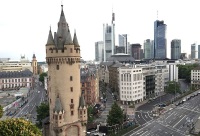
Eschenheimer Turm
The Eschenheimer Turm is one of the few remaining towers of Frankfurt's medieval fortifications. The 154-foot high (47m) Gothic tower was built in the 15th century, and was one of approximately 60 towers surrounding the city. The tower is both the oldest and the most unaltered building in the largely reconstructed city centre and is a striking Frankfurt landmark. The tower has eight levels and four smaller side-turrets, looking like something out of a fairytale. Now a popular tourist attraction in Frankfurt, there is a restaurant and bar at the base of the Eschenheimer Turm that offers a good place to relax and unwind after a day of seeing the sites.
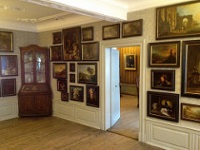
Goethe-Haus
The birthplace of Germany's iconic poet and writer, Goethe-Haus is now a shrine to Johann Wolfgang von Goethe's memory and preserved as an example of how the well-to-do lived in Frankfurt in the late Baroque era. The house, which is a reconstruction because the original was destroyed during World War II, consists of two neighbouring half-timbered houses in Grosser Hirschgraben and is situated next to the Goethe Museum, which contains a huge library of books, documents and graphics. Even if visitors aren't particularly interested in the writer, Goethe-Haus provides welcome insight into 18th-century Frankfurt. All the rooms are beautifully decorated and furnished, and many of the artefacts have recorded stories and associations from the Goethe family.
Frankfurt Botanical Gardens
The well-ordered and interesting Botanical Garden in Frankfurt is administered by the university and is a beautiful place to while away a few hours. The gardens are designed to take visitors on a journey through different areas of the plant kingdom, from the hardwood forests of North America to the vast savannahs of Africa. The gardens cover more than eight hectares (20 acres) and contain more than 6,000 different botanical species, from exotic rainforest flowers to European weeds. There is a playground in the gardens to amuse little ones, as well as miniature golf and a cafe.
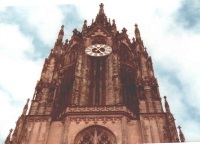
St Bartholomew Cathedral
St Bartholomew's Cathedral dominates the Frankfurt skyline with its imposing 311-foot (95m) spire, contrasting sharply with the modern skyscrapers in the downtown area. The cathedral was built in the 14th and 15th centuries, and has seen the crowning of kings and emperors. The architecture is traditional Gothic, with an interior boasting artistic treasures and striking carvings. The winding spiral stairs leading to the tower bells make for some spectacular views, with informative booklets educating guests on its history and the artefacts down below. As the cathedral is still an active place of worship, it's partially closed to tourists at times for services.
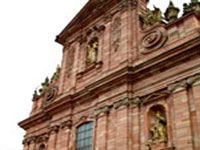
Heidelberg
The historic university town of Heidelberg is a city of music and romance along the Neckar River. One of the few German cities that escaped relatively unscathed from World War II, it boasts numerous Medieval and Renaissance buildings, including some beautiful historical churches and university structures from 1386. A good way to enjoy scenic views of Heidelberg is along the Philosopher's Walk, a path alongside the Heiligenberg. A vibrant atmosphere permeates Heidelberg, particularly in the student quarter with its narrow streets and lively pubs. The weather in Heidelberg is famously sunny and warm compared to much of Germany, and this is a major draw for the millions of tourists who visit each year.
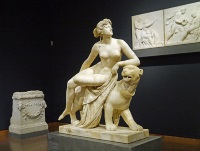
Liebieghaus
Built for a baron in 1896, the Liebieghaus is today the home of Frankfurt's Museum of Sculpture. It almost looks like a castle, with its beauty and majesty adding to a medieval atmosphere; exhibits cover ancient times from Sumeria and Egypt to Greece and Rome, as well as Baroque, Rococo and Renaissance periods. There are some 5,000 pieces in the collection, but the museum somehow still feels intimate and is usually less crowded than other big art institutions in Frankfurt. The Liebieghaus also puts up some great temporary exhibits showcasing modern sculptors, while tours and audio guides are both available.
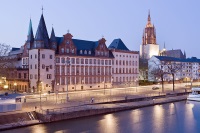
Historical Museum (Historisches Museum)
The Historical Museum has many permanent exhibitions featuring objects and works of art ranging from the Middle Ages to the present day. The museum's changing exhibitions cover a range of themes such as cultural history, art history and general history. Collections feature examples of gold and silver crockery and jewellery; pottery and porcelain; paintings and photographs; and scaled-down models of the Altstadt (Frankfurt old town) at various periods of development. The museum is useful for giving visitors an idea of how different Frankfurt looked before the damage of World War II. The Children's Museum, which lies adjacent to the Historical Museum, has a variety of special offers and exhibitions for youngsters of all ages.
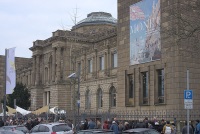
Städel Gallery
Frankfurt's most important art gallery is the Städel Gallery, which contains a fantastic collection of many European schools of painting and a revolving calendar of high-quality temporary exhibitions. The first floor features the works of German painters of the 19th and 20th centuries, as well as famous French Impressionists such as Renoir and Monet. The second floor offers an outstanding collection of Flemish Primitives, 17th-century Dutch artists and 16th-century German masters such as Dürer, Grünewald, Memling and Elsheimer, with one of the most prized paintings being Jan van Eyck's Madonna (1433).
English language tours are available, as are audio-guides for visitors who'd prefer to explore on their own. Those who have additional time, can enjoy workshops, talks and a research library. A café and bookshop are also located on-site.

Frankfurt Zoo
Located in Ostend and almost completely destroyed in World War II, the Frankfurt Zoo has grown to become one of the most popular in Europe. It's home to more than 3,200 animals from about 600 species, and is renowned for keeping them in environments that closely resemble their own natural habitats. A major drawcard for the zoo and one of its most unique features is Grzimek House, which is home to nocturnal animals. Other popular animals include tigers, penguins, rhinos, lions, crocodiles and hippos, as well as a vast collection of fish, insects and reptiles.
Senckenberg Museum of Natural History
One of the biggest natural history museums in Germany and housed in a UNESCO World Heritage Site, the Senckenberg Museum of Natural History features extensive exhibits on the biodiversity and evolution of life on Earth. A popular attraction is the fascinating palaeontology exhibit, which showcases fossils that date back over 50 million years; visitors will find fantastic display of dinosaurs that range from tiny trilobites to t-rex. There is also a floor dedicated to stuffed animals, including the world's largest collection of stuffed birds. English language guides are available, as are audio guides for visitors who'd prefer to explore the institution at their own pace.
The Fairy Tale Road
The German Fairy Tale Road follows a meandering 370-mile (595km) route through charming villages and gingerbread houses, lush forests and well-preserved medieval towns. It traces the path of the Brothers Grimm, famous storytellers who collected the folktales that inspired characters such as Sleeping Beauty, Little Red Riding Hood, and Hansel and Gretel.
Starting in their birthplace of Hanau, visitors explore attractions such as the Brothers Grimm National Monument in the town square, the Puppet Museum at Williamsbad, the Marienkirche and the Philippsruhe Palace. Further on, the town of Kassel is home to the Brothers Grimm Museum. From there, it's on to Hameln, the famous town of the Pied Piper, and the Fairy Tale Museum in nearby Bad Oeynhausen. The road ends in the town of Bremen, home of both the mythical Little Nienburg Girl and the very real Rathaus, a vibrant marketplace filled with town musicians and the famous Ratskeller Restaurant.
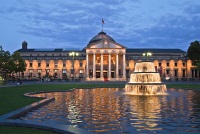
Wiesbaden
Situated in a valley between the Rhine River and Taunus Mountains, charming Wiesbaden is arguably Germany's favourite spa resort. Once enjoyed by the Ancient Romans, it offers 26 springs averaging around 105F (41C). Wiesbaden is also a cultural centre, its events focusing around the major Kurhaus concert hall complex. A walking tour is a great way to take in the historical and cultural attractions of Wiesbaden, with Wilhelmstraße replete with enticing boutiques and striking architectural landmarks. Another great activity is to catch the view from the Greek Orthodox Church on the hill, reached by the Nerobergbahn, a water-powered train that has been running since the late 1800s.
Eating Out
Frankfurt's diverse restaurant scene reflects the multicultural make-up of the city. Whether looking for German classics such as schnitzel, Eisbein and sauerkraut, local legends such as Frankfurter Hacksteak (chopped steak), or the very best of international cuisine, visitors will find it in the city.
Most traditional German restaurants are located in the Freßgass pedestrian street, and in Sachsenhausen, with apple-wine pubs set along cobbled streets bordering its row of museums. The best Frankfurt eateries serving modern and international cuisine tend to be in the city centre or Westend, while Nordend boasts some great cafes and a few more exotic establishments. There are quality restaurants all over the city and travellers can stumble onto something special almost anywhere.
Visitors should try apple wine, a popular drink in Frankfurt that tastes like cider and is referred to by the locals as Ebbelwoi. Of course, beer is also a staple in Frankfurt, just like in the rest of the country, and there are plenty of good bars and pubs to enjoy.
Frankfurt restaurants have various trading hours and it is best to call ahead and make reservations. Many include a service charge in the bill, as is the norm in most of Germany, but if this is not the case, a tip of about 10 percent is customary.
Shopping
The Zeil in Frankfurt is a large street where all the biggest stores and shopping centres can be found. This is the place to do a spot of clothes shopping, lazily browse through bookstores or look for end-of-season sales at the mainstream stores.
The Apfelwein district in Sachsenhausen is the best place to find traditional German souvenirs, with favourites such as ceramic German steins, lederhosen, cuckoo clocks and traditional Christmas decorations. For the peckish explorer, there are specialist food stores, cafes and delicatessens lining the upmarket Freßgass, ready to serve delicious local fare.
Travellers can head over to Goethestraße for top-end designer shops and jewellery stores in Frankfurt. Schweizerstraße, in Sachsenhausen, is home to exclusive boutiques and independent stores aimed at the trendier, younger market.
Most Frankfurt shops are open from 10am to 10pm, from Monday to Friday, and from 10am to 4pm on Saturdays. Most shops are closed on Sundays.
Nightlife
It might not be expected of a city known for its finance industry to have much of a nightlife, but with its high rollers and multicultural expats, Frankfurt parties hard after dark. Whether looking for an epic night in the club or a laid-back jazz session, Frankfurt will have plenty on offer to appease any taste.
Some of the best clubs in Frankfurt feature techno and house music, and the club scene is energetic and trendy. Those looking for something slightly more sophisticated will find that Frankfurt is one of the jazz capitals of Europe. For opera and classical music visitors should see what's playing at the Oper Frankfurt and the venerable Alte Oper, or check out one of Frankfurt's many wonderful theatres.
The city's nightlife is clustered around the northern area, near Freßgass, Zeil and Römerberg. The cobbled lanes of Sachsenhausen have some especially lively Latin, Irish and local establishments to enjoy for those homesick travellers longing for something familiar. Adult entertainment is also a booming industry in Frankfurt and the area known as Bahnhofsviertel is one of the largest red light districts in the world.
Getting Around
Public transport in the city is expensive but efficient, consisting of an integrated network of fast, modern underground U-Bahn lines, S-Bahn city trains, trams and buses. The U-Bahn and buses operate between about 4am and 1am, and there are also several night bus routes. Fares are standard and are based on a zone system, with most tickets valid for an hour and used for any number of transfers between all modes of public transport within that time.
Tickets must be bought prior to boarding. The Frankfurt Card (available from the tourist office) is good value, allowing for unlimited travel within greater Frankfurt, plus airport shuttle transport and discounted admission to museums. Taxis are safe and plentiful, but expensive, while ride-sharing apps also operate in the city. Driving a car in the city involves rush-hour congestion, expensive parking lots and confusing road systems, so it's best to use public transport instead.
Frankfurt Climate and Weather
Frankfurt has a temperate oceanic climate, characterised by warm summers and cold winters. Temperatures are not extreme and almost never severe. Summers are sunny and warm but can also be quite wet, with frequent rain and sometimes quite high humidity. Winters are fairly cold and can bring occasional violent storms. Light snowfall is to be expected and it can get windy which adds to the chill factor. The average temperature in mid-winter (January) is 34F (1C), and in mid-summer (July) the average temperature is 66F (19C). Although summer is definitely the best time to visit Frankfurt, it is also the most popular time and it can get busy, crowded and expensive. Outside of this period, visitors can get pleasant weather and plenty of sunshine in spring (April and May) and autumn (September and October).
Germany travel info
Electricity
230 volts, 50Hz. European-style two-pin plugs are standard.
Language
German is the official language. English is also widely spoken and understood.
Money
The unit of currency is the Euro (EUR), divided into 100 cents. ATMs and exchange bureaux are widely available. The major credit cards are widely accepted in large shops, hotels and restaurants. The quickest and most convenient way to change money is to obtain cash from one of the ATMs that are ubiquitous features on all German streets. Banks are closed on weekends, but exchange bureaux at airports and main railway stations are open daily.
Tipping
German law stipulates that all prices, menus and bills include both tax and a service charge, so tipping is not necessary in restaurants. Cleaning staff, hairdressers, taxi drivers and other menial services appreciate small tips.
Health
There are no serious health risks for visitors to Germany and no vaccinations are required. The German health service is excellent and there is a reciprocal health agreement with most EU countries, whose citizens are entitled to free medical and dental treatment on presentation of a European Health Insurance Card (EHIC). After Brexit, the Global Health Insurance Card (GHIC) replaced the European Health Insurance Card (EHIC) for UK citizens. The GHIC allows UK citizens access to state healthcare during visits to the EU. The GHIC is not valid in Norway, Iceland, Liechtenstein or Switzerland, nor is it an alternative to travel insurance. Nationals of other countries should take out travel insurance.
Safety
A visit to Germany should be trouble free, but visitors should take normal precautions to avoid mugging, bag-snatching and pick-pocketing, especially at airports, railway stations and markets in the large cities.
Local customs
Visitors are not required to carry their passports with them at all times in Germany, but carrying some form of identification is advised. Smoking in public places such as bars and restaurants is illegal.
Doing business
In Germany, business is conducted in a formal manner, with a conservative and formal dress code being the norm. Punctuality is vital at all meetings and it's considered rude to be late. Germans use titles often, with men referred to as 'Herr' and women as 'Frau', followed by their last names.
Meetings are often purely business and may not occur over lunches, which are generally more social. Shaking hands at the beginning and end of the meeting is common. Business hours are generally 9am to 6pm Monday to Friday, with an hour taken over lunch.
Duty free
Passengers arriving from EU countries can enter Germany without paying duty on 800 cigarettes or 400g cigarillos or 200 cigars or 1kg tobacco; 90 litres of still wine; 110 litres of beer; and 10 litres of alcohol stronger than 20 percent or 20 litres of fortified wine, sparkling wine or other liqueurs up to 22 percent.
Passengers arriving from non-EU countries, over the age of 17, can enter Germany without paying duty on 200 cigarettes or 100 cigarillos or 50 cigars or 250g smoking tobacco; 4 litres of wine and 16 litres of beer and 1 litre of spirits over 22 percent volume; or 2 litres of spirits under 22 percent volume. Other goods to the value of €430 for travellers arriving by air or sea, and €300 for travellers arriving by land.
Communications
The international access code for Germany is +49. Travellers will find it easy to use a local SIM card, Skype, WhatsApp or similar apps. Free WiFi is available in most hotels, cafes and restaurants.
Passport & Visa
The borderless region known as the Schengen Area includes the following countries: Austria, Belgium, Czech Republic, Denmark, Estonia, Finland, France, Germany, Greece, Hungary, Iceland, Italy, Latvia, Lithuania, Luxembourg, Malta, The Netherlands, Norway, Poland, Portugal, Slovakia, Slovenia, Spain, Sweden, and Switzerland. All these countries issue a standard Schengen visa that has a multiple entry option, and which allows the holder to travel freely within the borders of all the aforementioned countries. Additionally, non-EEA members require proof of onward or return tickets, the necessary travel documentation for their next destination, and sufficient funds to support themselves while in Germany. Citizens of Australia, Canada, Israel, Japan, New Zealand, Switzerland, and the USA are exempt from the requirement to hold onward tickets.
It is highly recommended that travellers' passports have at least six months' validity remaining after the intended date of departure from their travel destination. Immigration officials often apply different rules to those stated by travel agents and official sources.
Entry requirements
US citizens must have a passport that is valid for three months after the period of intended stay in Germany. A visa is not required for stays of up to 90 days within a 180 day period.
UK citizens must have a passport that is valid for three months after the period of intended stay in Germany. A visa is not required for stays of up to 90 days within a 180 day period.
Canadian citizens must have a passport that is valid for three months beyond the period of intended stay in Germany. A visa is not required for stays of up to 90 days within a 180 day period.
Australian citizens must have a passport that is valid for three months beyond the period of intended stay in Germany. A visa is not required for stays of up to 90 days within a 180 day period.
South African citizens must have a passport that is valid for three months beyond the intended period of stay, and a valid Schengen visa, to enter Germany. Note that Temporary passports will not be recognised.
Irish citizens must have a passport that is valid on arrival in Germany. A visa is not required.
New Zealand citizens must have a passport that is valid for three months beyond the period of intended stay in Germany. A visa is not required for stays of up to 90 days within a 180 day period.
Useful contacts
German National Tourist Board, Frankfurt: +49 (0)69 751 903 or www.germany-tourism.de
110 (Police); 112 (Ambulance/Fire)Embassies / consulates in other countries
German Embassy, Washington DC, United States: +1 202 298 4000.
German Embassy, London, United Kingdom: +44 20 7824 1300.
German Embassy, Ottawa, Canada: +1 613 232 1101.
German Embassy, Canberra, Australia: +61 (0)2 6270 1911.
German Embassy, Pretoria, South Africa: +27 (0)12 427 8900.
German Embassy, Dublin, Ireland: +353 (0)1 269 3011.
German Embassy, Wellington, New Zealand: +64 (0)4 473 6063.
Embassies / consulates in Germany
United States Embassy, Berlin: +49 (0)30 83050.
British Embassy, Berlin: +49 (0)30 20 4570.
Canadian Embassy, Berlin: +49 (0)30 203 120.
Australian Embassy, Berlin: +49 (0)30 880 0880.
South African Embassy, Berlin: +49 (0)30 220 730.
Irish Embassy, Berlin: +49 (0)30 220 720.
New Zealand Embassy, Berlin: +49 (0)30 206 210.



